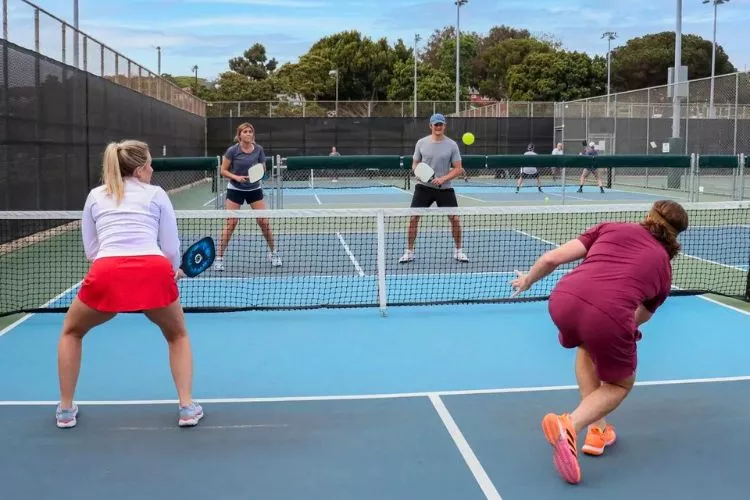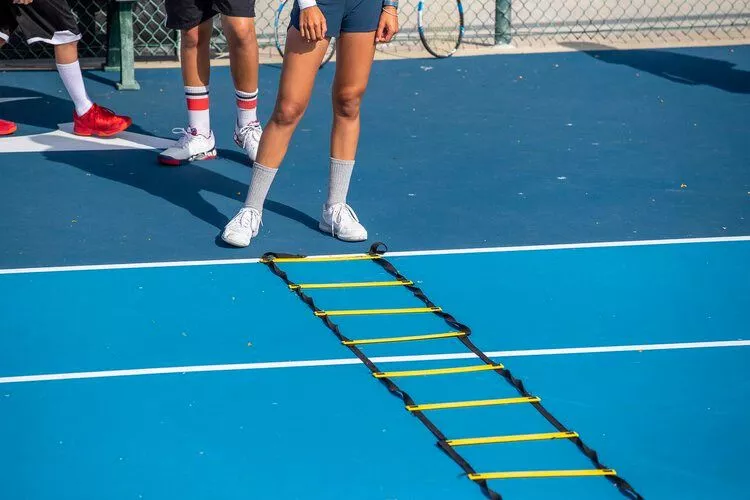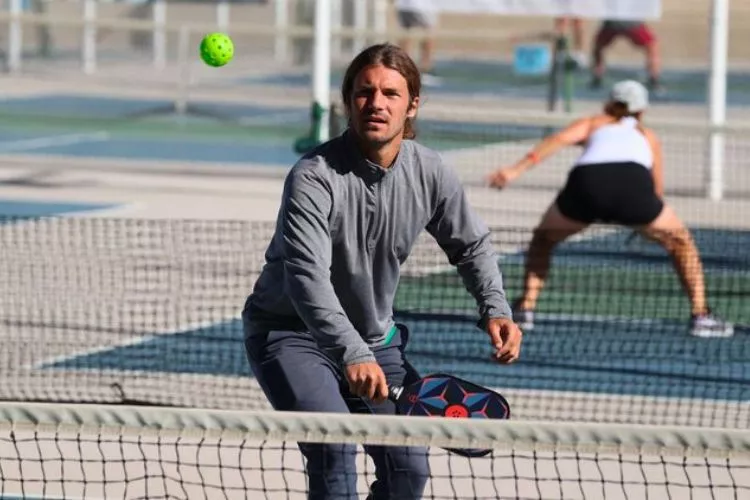Pickleball, a popular fast-paced sport, has its share of unique terminologies and advanced strategies.
Among these terms, “Erne in pickleball” is one that often leaves players curious and eager to learn.

This article delves into the nuances of the Erne in Pickleball, its implications on gameplay, and how it can be an effective technique for seasoned players.
Get ready to unravel the mystery behind this maneuver and elevate your Pickleball performance to new heights!
What is an erne in pickleball?
An Erne is an aggressive, offensive maneuver in Pickleball, executed by a player to intercept the ball close to the net and finish a point with a strong shot.
Named after Erne Perry, who popularized the move, it involves stepping just outside the non-volley zone (also called the kitchen) adjacent to the sideline, reaching in, and hitting the ball at a downward angle, typically catching the opponents off-guard.
The Erne capitalizes on surprise, speed, and precision, making it challenging to defend against. However, it’s crucial to stay out of the non-volley zone when attempting an Erne, as stepping in the zone while hitting the ball results in a fault.
The successful execution of the Erne requires practice, good footwork, proper positioning, and anticipation of the opponent’s shot.
When employed effectively, the Erne enables players to gain a tactical advantage during matches and put pressure on their opponents.
Understanding the Non-Volley Zone in Pickleball
In Pickleball, the court is a key aspect. It plays a huge role in the game. One critical part of the court is the non-volley zone.
This zone has various names. Some call it “the kitchen”. Others call it the NVZ. In all cases, this zone affects how players move. It also affects the kind of shots players can play.
The non-volley zone is a seven-foot space on both sides of the net. It extends all the way to each sideline. This creates a “no hit” zone near the net.
Players in this zone cannot hit the ball before it bounces. If a player hits a volley (a shot before the ball bounces) while in this zone, they commit a fault. The point then goes to the other team.

The NVZ rule discourages players from rushing to the net. It aims to stop them from continuously slamming the ball downwards. This allows for longer, more strategic rallies.
Here’s where the Erne comes in. This shot gets its name from Erne Perry. Perry was a player who found a smart way to make a net shot. You execute the Erne by stepping outside the non-volley zone. You then reach into the zone to hit a volley.
The Erne is a fair move. Yet, it needs skill, control, and precision. You must keep your feet outside the zone when you hit the ball. You have to be sure not to touch the NVZ. A foot fault can result in losing the point.
Understanding the non-volley zone is vital in Pickleball. It helps you know the rules. It also opens up strategies like the Erne. It can give you a much-needed edge in the game!
Techniques for Executing an Erne Effectively
The Erne shot is a useful move in Pickleball. It requires skill, timing, and footwork to do it right. To perform an Erne shot, follow these steps:
- Anticipation: Be aware of the game. Watch your opponent’s moves. Look for chances to intercept a shot.
- Positioning: Stand close to the non-volley zone. Don’t enter the zone before hitting the ball. Split-step your feet and stay on your toes. Keep your weight forward to stay agile.
- Move Quickly: When you see an opportunity, move fast. Get to the sideline close to the net. Stay just outside the non-volley zone. “Disappear” from the view of your opponents.
- Reach and Hit: As the ball approaches, extend your arm. Keep your feet outside the non-volley zone. Reach inside the zone with your paddle. Strike the ball at a downward angle. Make your shot quick and decisive.
- Recovery: After hitting, retreat from the zone. Get back in position. It allows you to defend against counter-shots by your opponents.

Now, here are some tips to improve your Erne shot:
- Tip 1: Practice Footwork: Good footwork prevents faults. Train to move fast without stepping into the non-volley zone. Confidence in your movement is key.
- Tip 2: Paddle Control: A good Erne requires control and precision. Focus on hitting the ball at the right angle and speed. Hitting the ball close to the tip of your paddle adds more power.
- Tip 3: Choose the Right Time: Timing is vital in Pickleball. Make sure the ball is at its peak before swinging. Your shot will be more powerful if you hit the ball at its highest point.
- Tip 4: Surprise Your Opponent: The Erne works best when unexpected. Prepare to surprise your rivals. When they don’t see it coming, they will have less time to defend.
- Tip 5: Communicate with Your Partner: Teamwork is critical in Pickleball doubles. Inform your partner when you plan to make an Erne shot. Your partner can cover you if the opponents return the shot.
- Tip 6: Analyze Your Opponent’s Patterns: Notice their habits. Be aware of how they hit the ball. Use this knowledge to predict when and where to play the Erne.
Perfecting your Erne shot takes practice. Work on each step of the process. Pay attention to footwork, position, and timing. By mastering this move, you will become a more advanced Pickleball player.
Strategies for Defending against an Erne
The Erne is a tricky shot to defend against, but with the right tactics, it can be done. Here are a few strategies:
- Avoid Predictable Plays: Predictable shots are easy targets for an Erne. Mix up your shots for unpredictability. You want to prevent them from guessing where your next hit will land.
- Keep Shots Low: High shots are easy to Erne. Lower shots are harder. A low shot must bounce first in the non-volley zone. That prevents the Erne from happening.
- Force Deep Returns: Keep your shots deep in the court. That forces your opponent to stay back. They won’t be in a good position to execute an Erne.
- Control Sidelines: Watch the sidelines closely. An Erne player needs to step to the side to make their shot. If you control the sidelines, you limit their options.
- Use Middle of the Court: Keep your shots towards the middle of the court. Aim away from the non-volley zone. That makes it tough for the opponent to perform an Erne.
- React Fast: If your opponent goes for an Erne, be quick to react. Adjust your position. Get ready to return the shot.
- Observe Opponent’s Positioning: Notice if your opponent goes close to the non-volley zone often. They could be waiting to execute an Erne. If they are, change your shot strategy.
- Practice Defense Drills: Know how to respond to an Erne. Practice a series of defense drills. That prepares you to return the shot.
- Communicate with your Partner: In doubles, team play is important. If you see your opponent move for an Erne, quickly alert your partner. Both of you can adjust your positions.
Defending against an Erne takes skill and quick thinking. Remember to stay unpredictable and control your shots.
Always keep an eye on your opponent’s positions. And react fast to their moves. With these strategies, you will be better prepared to defend against an Erne.
Practice Defense Drills to Defend against the Erne
Defending against an Erne shot in pickleball requires skill, speed, and anticipation, all of which can be developed and improved through targeted defense drills.
Here’s an in-depth look at some useful drills to help you prepare for this challenging offensive move.

Sideline Tracking Drill
This exercise improves your agility and quickness necessary for narrowing down the successful Erne opportunities for your opponent. The drill involves swiftly moving back and forth along the sideline while maintaining your feet outside the non-volley zone, mimicking the defensive position to an Erne shot.
Low Shot Drill
Practicing low shots is key to preventing your opponent from executing an Erne shot, as it forces the ball to bounce in the non-volley zone before it can be hit. A partner reliably sends you high shots from the other side of the court that you, in turn, must return as low as possible over the net.
Middle Shot Drill
Hitting to the middle of the court restricts the opportunities for your opponent to make an Erne shot. To practice this, place a target in the center of your opponent’s court. Aim your shots at the target, focusing on precision and accuracy.
Fast Reaction Drill
This drill gears you to respond quickly to an Erne. From the baseline, have a partner send a variety of shots toward you, some easy to respond to and some more challenging, like sudden near-net shots.
Deep Return Drill
The goal of this drill is to push your opponent back and to the sides, far from the net and beyond the reach of a possible Erne shot. Practice returning shots as deeply into the opponent’s court as you can.
Defensive Position Drill
A partner executes mock Erne shots while you practice quick repositioning. This helps to improve your court tracking skills, aiding you to move swiftly in response to an Erne shot.
Communication Practice
In doubles, practice communication with your teammate. Call out when you see an opponent shifting for an Erne to coordinate an effective defense. You could practice this during match-like situations in your drill sessions.
Remember, consistent practice is key to develop and enhance these skills, making you prepared and apt in handling an Erne shot effectively on the court. Don’t forget to incorporate these drills into your training routines. Good luck!
Can you step in the kitchen before an ernie?
No, you cannot step in the kitchen, or the non-volley zone, before you hit an Erne shot in pickleball. The key to a successful Erne is maintaining correct footwork. While executing this shot, your feet must stay outside the non-volley zone.

You can reach into the zone with your paddle to hit the ball, but if any part of your foot touches the non-volley zone before or while making contact with the ball, it is considered a foot fault and results in a loss of the point.
This rule ensures a balanced playing field and prevents players from gaining an unfair advantage near the net. Therefore, while executing an Erne, preventing a foot fault is a top priority.
Conclusion:
In summary, an Erne in pickleball is a calculated and strategic play that can catch opponents off guard if executed effectively.
Named after Erne Perry, who popularized it, this move involves striking the ball directly from the air while positioned at the edge of the non-volley zone, skillfully avoiding a foot fault.
Detailed understanding of the game, agility, good footwork, and keen anticipation form the base of pulling off a successful Erne. However, despite its advantage, it’s important to remember that an Erne is a high-risk shot and should be used selectively.
Training with purpose, focusing on the technique, and adopting a strategic approach while balancing offensive and defensive play can significantly improve your overall pickleball game, setting you up for success on the court.
As with any advanced move, practice makes perfect. So, get out there, have fun, and maybe even Erne yourself a few extra points!

Pickleball’s more than a game to me—it’s a passion. I write, sharing its highs and lows, the thrills and the lessons. Some tales might draw you to the court, while others give a hint of the game’s magic. So, curious about my journey? Ready to dive deep into the world of pickleball with me? Let’s go.
